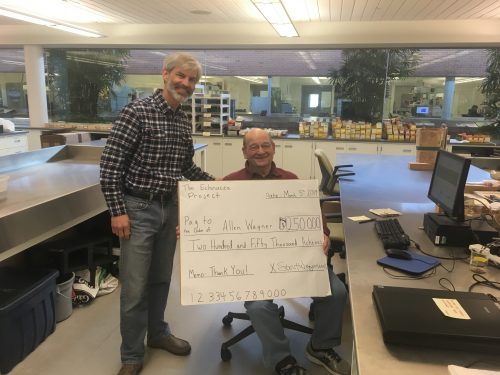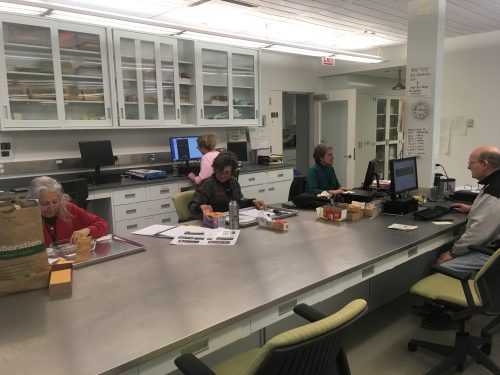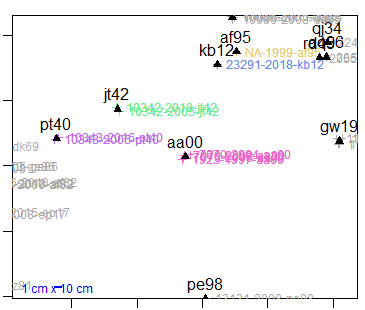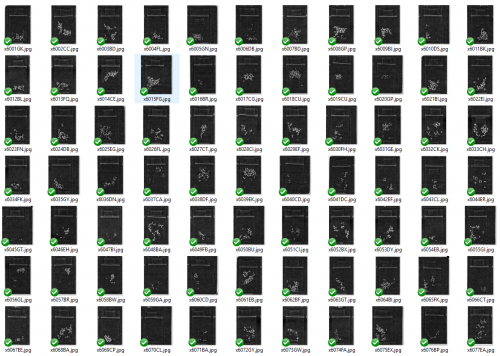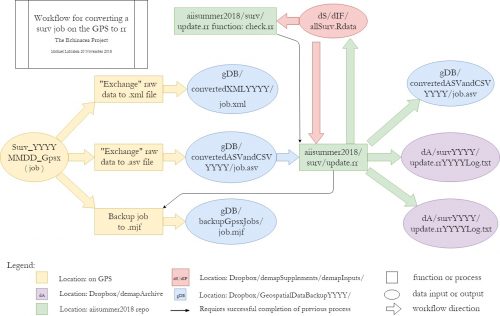|
|
Here on the flog, we like to talk about how much of the important work around the lab is done by our volunteers. Last week Allen, one of our long-term volunteers, hit a huge milestone and showed us just how much he does for the project.
Allen has officially counted a quarter of a million achenes.
Allen reached this number faster than usual, counting up to his quarter million in just a bit over two years. We’re super thankful for all of the work Allen has done for the project. And of course, what better way to show our thanks than a big check?
 Allen, Stuart, and a big check In the future, Allen will continue to count achenes and hopefully hit many more large milestones in his counting.
Thank you Allen!
Hi Flog,
It’s business as usual here at CBG, and we’re hard at work trying to finish counting the achenes from heads that were harvested in 2015. It may sound like we’re a little behind on counting, but that’s only because there’s simply so many achenes to count! In 2018, volunteers at the project counted over 800,000 achenes, and we’re certainly striving to beat that in 2019.
Tuesdays are particularly fun in the lab because it is far and away the most full time. Marty and Allen count achenes while Laura classifies. Shelley is randomizing and Naomi is cleaning. All in the name of progress! Hopefully as some of our volunteers return from their winter getaways we’ll start grinding through some of the 2016 counting, and we’ll certainly start cleaning all the heads from 2018 within the month.
 Our full lab! Look for more updates soon on how our counting and cleaning is going!
Michael
Hi Flog!
One of the biggest task we do here at the echinacea project is what we call demap. Demap is our shorthand for “demography map” and is also certainly in no way a testament to our ongoing support of Bill Swerski’s Superfans and how they may pronounce “the map.”
In demap, our goal is to take all of the field records from remnant populations of echinacea that we spend many weeks collecting and make them look all nice and pretty. If you ever doubt just how long that this data takes to collect, do a search of our “daily updates” category and count the percent of days that include the word “demo” or “surv.”
Where the true magic happens with demo, as with many things with the Echinacea Project, occurs in R. There, we are able to take all the location records and all the flowering data for every plant for every year, and create a big, beautiful map.
 A small, but still beautiful map. The big one is a little to crowded and confusing 😥 Why mention demap now in the middle of February? While we finished collecting the data back in October, just yesterday we finished making sure it was all accurate. It may have taken a while, but it’s always worth it for high quality data!
Have a great weekend!
Michael
We all know how the situation goes. You get home from a long day of work, take off your shoes, flop down on the couch, and think to yourself “There’s no way that there’s very much variation in echinacea flowering from year to year. ”
I know, we’ve all been there.
I’m here to tell you that, despite what you might think, there is HUGE variation in echinacea flowering from year to year. When these punctilious perennials decide that it’s time to flower, they really seem to go at it as a group.
And if you’re still sitting there thinking “Well a small amount of year to year change is to be expected” then let me hit you with some visual proof.
Here is a picture of ALL of the heads from Experimental Plot 1 in 2017. They fill up about 1 grocery bag total. Not a bad haul!
 Our plot 1 heads from 2017 Now, let’s take a look at 2018. I spy just a few more bags than in 2017:
 Our plot 1 heads from 2018 in many bags Now it’s time for the real question: why? What is it that makes echinacea flower in these large groups? They cant phone a friend and say “hey dude, you gonna flower this year?” They must respond to signals or communicate chemically or do any of a hundred other things to flower in groups like this. All I know is that we’ve got a lot of 2018 cleaning in our future.
Hello Flog!
I know you’ve all been sitting on the edge of your seats waiting for your most recent update on our push to xray our achenes. Wait no longer! I’m here to inform you that as this is being posted the last of the 2016 achenes are being assembled. 2016 is the most recent year for which we have every head cleaned and randomized, and marks the beginning of the end for our backlog. Very soon we will be seeing some 2016 seed sets. Exciting!
Implied above, this also means that 2015 is fully assembled. 2015 was the largest year of flowering ever for the project with over 3000 heads. Not to fear: they’re all cleaned, randomized, xrayed, and ready to be classified.
 All of our assembled 2015 achenes Tune in next week for an update on the status of the polLim experiment xrays. expect good news!
Michael
Hello flog!
For those of you who read all of my flog posts (I know there’s a solid number of you out there!) you’ve probably figured out by now that I love posting about numbers. So what’s today’s number?
Why, it’s 1948 of course!
Now this is the point that you might furtively look at wikipedia and say “I don’t understand what 1948 has to do with Echinacea. Everyone already knows that 1948 was a leap year starting on Thursday of the Gregorian calendar, the 1948th year of the Common Era (CE) and Anno Domini (AD) designations, the 948th year of the 2nd millennium, the 48th year of the 20th century, and the 9th year of the 1940s decade.” To which I would say that we are dealing with the number 1948, not the year.
No, 1948 is the number of seed packets of echinacea we x-rayed at the garden this week: and it’s only Wednesday! Through the combined efforts of many volunteers we are making some headway into the daunting task of figuring out which achenes have seeds in them and which do not. Look for updates soon about these number for our pollen limitation heads!
Michael
p.s., here’s a small sampler of what the xrays look like
 A look at our qGen_a xrays from 2013. There’s almost 900 images total in this folder (not nearly that many are shown here)
Here at the Echinacea project, we like to count things. We like to count achenes, pollen, seeds from liatris and solidago, and really anything that will get us data. So, I am happy to give our (almost) full counting report from 2018.
This year, members of Team Echinacea counted over 717,000 achenes.
I, Personally, am wowed by this number,for not only does it mean that our team had to sit and click a computer screen 717,000 times, but it also means that we have roughly 1/3 that number of achenes sitting on the shelf right now! And that’s just from this year!
Thanks all for a great year of counting, and I hope we count even more next year!
Michael
Here at the Echinacea Project, we have some pretty rigorous protocols to make sure that everything goes right. This applies doubly so when it comes to ACE — the process we use to make sure we count all of the achenes on every head (hence the acronym, Accurately Count Everything). The process starts when we harvest the head in Minnesota in August or September, and ends sometimes years later when we have classified the last xray, with rigidly defined steps in between. This process leads us to a data set that has a human error rate of less than 1%
This is a story about that <1%
In fact, I would argue that this is a story about the 1% of that <1%. A head that has not only 1 terminal error associated with it, but 3.
This is the story of CG2016 XD-9460.
My experience with this head, whom we’ll nickname XD, began when Tracie gave me a list of the necessary rescans for 2016. These are the heads that, for some reason, never had their achenes scanned. They can be particularly troublesome because usually their achenes are in 3 separate places as part of ACE protocol that normally comes after the scanning step. I had gotten XD’s achenes from 2 of the 3 locations, and went to look for its orange coin envelope — the envelope that contains most of its achenes.
It wasn’t in the first place I looked, where it should be.
It wasn’t in the second place, where it shouldn’t be.
Nor was it in the third, fourth, or fifth places I looked, where it definitely shouldn’t be.
In fact, it was no where I looked. After an upsettingly long and painfully fruitless searching process, I decided to check and see who had cleaned XD, and maybe that would give me a clue where the envelope was. To my surprise, I saw the label that should have been on XD’s orange envelope still on the master label sheet, and the words “head not here” written in the notes section by the volunteer assigned to clean it.
How then, did we have some achenes for XD if the head was never cleaned? How did we have achenes if the head was never here?
This is an insight into our ACE protocol. Even with our organization and attention to detail, things can go wrong in ways we could never predict. After I completed my detective work, here is what I believe happened to CG2016 XD-9460. This is the verbatim note I have left in our “missing scans” log. It is unusual for this log to contain more than 10 words about each head.
1:56 12/5/2018 MCL
XD-9460 has more than one error associated with it. This is my best guess as to what happened.
Error 1. On the day it was harvested, the harvester came to a plant that had two heads on the ground: XD-9460 and XM-9011. The harvester put both heads in the same bag and made a note of it. I believe that bag was labelled XM-9011
Error 2. When it came to cleaning, XM-9011 was cleaned normally, and no note of a second head was ever made. I believe only one head was selected from the bag (either 9460 or 9011), labelled as XM-9011, and processed, while the other was ignored.
Error 3. During randomizing 9460 was not skipped, despite having no seed packet associated with it There is a white envelope and clear baggie with achenes “from XD-9460” in it; however, seeing as that is not possible, they come from a completely unknown source.
So there you have it. A story that took up a few hours of my time, so I thank you for taking a few minutes of your time to read it. If you’re wondering what happened to the data from this head, it has been labelled as “lost in the field” and wont poorly influence our analyses (or torture our lab managers) anymore.
Have a good weekend!
Michael
Hey, my name is Leah Rose and I am an intern from Lake Forest College! During the last few weeks, I have been working with Stuart Wagenius and Michael LaScaleia to research pollen limitation in Echinacea angustifolia to see if there is an effect on lifetime fitness when the flowers are loaded up with pollen and when they don’t get any pollen. I have loved getting a hands-on experience with researching these important native plants and helping make an impact on conservation of our native prairies! As a future high school biology teacher, experiencing science and conducting research is very important to me and I want to show my students that they can be a part of research such as this in the future. Science is for everyone and introduces you to people and subjects outside the usual scope of our lives!
Here is a picture of me totally beating Emma’s achene count! #winning

Hello Flog,
As we wrap up these short few days before Thanksgiving in the lab I would like to share with you some of the very behind the scenes data management we do here at the Echinacea Project. For the last few weeks, we have been working on revamping our workflow for how we add GPS points into our 24-year dataset. Ultimately, this was our result:
 How we take the data on the GPS (the bubble on the left) and get it into all the different formats we need Well maybe this isn’t exactly “light” reading, but it does offer an insight to just how many steps there are to managing this data.
Hope you all have a wonderful Thanksgiving!
Michael
|
|

